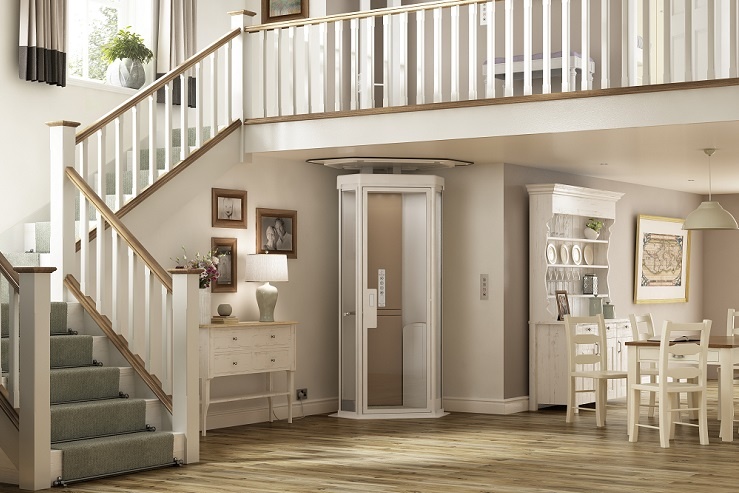
As a business that has been making and supplying lifting products for over 150 years we know a thing or two about lifts and consider ourselves specialists in hydraulic lifts. For low-rise applications, hydraulics are a reliable and cost-effective drive system with plenty of lifting force and in-built safety. We use the same kind of drive system on our homelifts as we do in top-quality commercial lifts.
A hydraulic lift pumps fluid into a ram that pushes a lift up, when the lift descends the fluid flows back into the reservoir. In comparison traction and rope and drum lifts use steel ropes to pull the lift up, either by winding the rope onto a drum or using counterweights.
As with everything in life each system has pros and cons.
At Stannah we have chosen hydraulics to drive our lifts because they are:
- Reliable, proven technology
- Allow pump mechanisms to be located up to 10m away, therefore:
- Minimising noise
- Maximising interior cabin space
- Minimising external headroom required
- Easier access for servicing
- Energy efficient
Hydraulic vs Traction
Traction lifts require more height on the top floor to accommodate the lifting mechanism. Typically on a rope and drum drive, the lifting mechanism is incorporated into the lift car which can make the top of the lift look very bulky and can be noisy. Having the lifting mechanism incorporated into the car also reduces the internal headroom of the lift in addition to requiring additional external headroom. This can also mean that where ceilings are low in an upstairs room there may be a requirement to cut into the loft space to accommodate the lift.
Hydraulic lifts also require less headroom and allow the quiet drive mechanism to be placed up to 10 metres away from the lift, in a cupboard or even outside, maximising space on the floor, cabin space and further minimising noise.
Running Costs and Maintenance
Homelifts are generally cheap to run, using only a similar amount of electricity as a small household appliance. Some will claim that traction lifts are more energy efficient than hydraulic lifts, which is true to a certain extent for counterweighted lifts. For rope and drum lifts any difference is unclear.
Some people are concerned that hydraulic lifts may come with a risk of leaking hydraulic fluid, often oil, which can be detrimental to the environment. Indeed, there is a theoretical risk but in reality it is very rare and only as likely as rust or corroded cables on a traction lift.
The speed of domestic lifts is regulated under BS5900:2012 to 0.06m per second and both traction and hydraulic lifts can easily match regulated maximums.
Hydraulic lifts can be remarkably quiet depending on the placement of the pump unit. Sensible placement of the pump will allow the lift to operate almost silently, especially on the downward journey. Noise levels on traction lifts can vary depending on the mechanism used and condition of the motor, rope and gear mechanism.
The remote placement of a hydraulic pump also allows for ease of access for servicing.
All homelifts have to have some sort of safety mechanism in the very rare event that a lift free falls. Hydraulic lifts have a safety valve that regulates the flow of hydraulic fluid in the down direction. If, for instance, a pipe were to be cut, the fast flow of hydraulic oil would be stopped by the safety valve stopping the lift from free falling. An added safety element is that the large mass of oil flowing through a small hole is in itself is a flow regulator. Traction lifts have alternative emergency breaking mechanisms.
What happens if there’s a power cut?
In the event of a power cut, all homelifts use a battery backup that will allow a user to descend to the ground floor but they will not be able to travel up. However, even under battery power, the safety edges on all our homelifts will still operate.
Hydraulic lifts also allow for easy manual release at just the flick of a switch. Manual release on traction and rope and drum lifts are operated by handles or wheels and often require assistance from a service engineer.
Both kinds of lifts should offer the optional extra of uninterrupted power supplies (UPS) that will allow for travel up and down during a power cut.
BS 5900 regulations state that homelifts should be connected to a dedicated spur rather than simply plugged into a 13amp socket. Our installation service includes this as standard.
Whether a lift has a traction or hydraulic drive has no bearing on whether it is self-supporting: virtually all compact lifts are self-supporting including all Stannah compact homelifts.
In conclusion, we see hydraulic lift drives as the perfect choice for compact home lifts.
Stay up to date
Latest Blogs

Whole Home Comfort with Stannah and HSL

Dame Zandra Rhodes x Stannah: When accessibility meets style
Could more people benefit from home adaptation support for hidden disabilities?
50 years of Stannah Stairlifts – A milestone grounded in purpose

BBC’s Dr Punam Krishan reveals a little-known Parkinson’s symptom to watch for...

Are you at risk of falling? Dr. Punam Krishan’s simple 12-second test could tell you...

Snore Wars: Could sleeping separately be the secret to a better night’s rest?

Proud to carry the Made in Britain mark!
Stairlifts made for you
All our stairlifts whether straight or curved are customised to suit you and your home so call now to arrange a visit to get your FREE personalised quote!